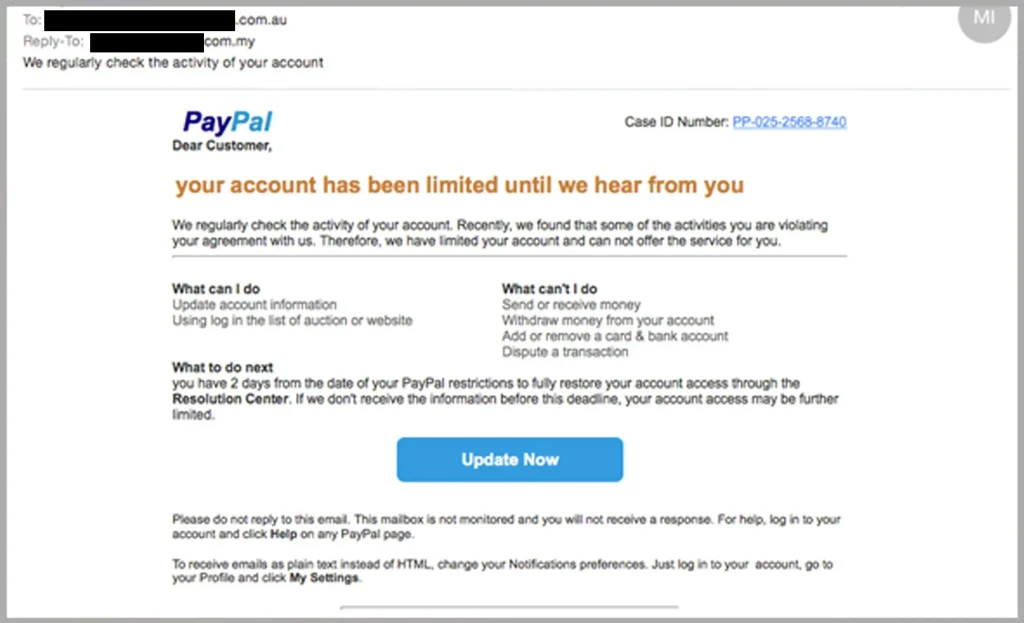The recent surge in the PayPal phishing scam has left even the most vigilant users at risk of falling prey to sophisticated schemes. Unlike previous scams littered with poor grammar and false URLs, this tactic utilizes PayPal’s legitimate email system, leading unsuspecting victims to believe they have received authentic alerts. Imagine opening an email that claims, “You added a new address to your account,” even if you never initiated such a change. This unsettling situation highlights the urgency to learn how to spot PayPal scams and prevent becoming a victim. To safeguard your financial information, understanding how to report PayPal phishing attempts is crucial in ensuring your safety against this escalating threat.
In recent times, fraudulent schemes involving digital payment platforms like PayPal have become increasingly deceptive. Dubbed as the latest email scam targeting users’ trust, these scams cleverly mimic official PayPal communications, leveraging urgency to provoke hasty decisions. Many individuals are unaware of the signs that reveal a scam, leading to significant security breaches. As these counterfeit messages circulate, it is essential for users to recognize techniques used by scammers to compel users into disclosing personal information. By remaining informed about the updated PayPal scam landscape, users can effectively defend against these threats and avoid falling victim to scams.
Understanding the New PayPal Phishing Scam
The latest PayPal phishing scam has emerged as a significant threat, impacting even the most security-aware users. Unlike traditional scams rife with questionable grammar or bizarre email addresses, this new scheme cleverly mimics the official PayPal communication style. Scammers have learned to harness PayPal’s systems, sending emails that appear genuinely from PayPal, such as alerts about adding an address. This makes it challenging to identify scams, and users may find themselves confused or even alarmed by seemingly legitimate messages.
The method behind these scams involves exploiting real PayPal features. Scammers initiate the scam by manipulating PayPal’s legitimate functions to trigger automated notifications. For instance, by merely entering someone’s email, they can generate real emails from a verified PayPal domain. This tactic allows them to bypass email filters and security, as the messages land directly in users’ inboxes without raising flags. The sophistication of these attacks indicates a shift in how phishing scams operate, making it essential for users to remain informed and cautious.
Recognizing the Tactics of PayPal Email Scams
To effectively combat phishing attempts, it’s crucial to understand the methods used by scammers. One of the primary tactics employed in the PayPal phishing scam is urgent messaging. Emails often contain alarming statements about unauthorized address changes or large pending transactions, designed to provoke an immediate response. Users may feel pressured to act swiftly to secure their accounts without taking the time to verify the authenticity of the message.
Moreover, the absence of links in these communications is particularly alarming. Instead of a phishing link, users might find a phone number to call. When contacted, victims are misled into believing they are speaking to legitimate PayPal representatives. This tactic not only increases the level of trust but also complicates the detection of the scam, as victims end up providing sensitive information unwittingly. Understanding these strategies can empower users to identify phishing attempts more effectively.
The Urgency and Panic of PayPal Phishing Messages
Urgency is a central element in the effectiveness of PayPal phishing scams. Scammers craft their messages to evoke quick reactions from recipients. Phrases that warn of account activity or highlight the necessity of immediate verification are common. By instilling fear or anxiety, they compel unsuspecting individuals to act before thinking, which can result in disastrous outcomes. Users must learn to recognize this tactic to avoid falling prey to these fraudulent schemes.
Additionally, the psychological manipulation used in these scams can lead to serious repercussions. When individuals act without pausing to verify the source of the email or the legitimacy of a phone call, they expose themselves to identity theft and financial losses. It’s essential to take a step back when receiving unexpected notifications and verify their authenticity through official channels instead of responding directly to the communication.
How to Identify a PayPal Phishing Email
Identifying PayPal phishing scams requires a keen eye for detail. Firstly, look for discrepancies in the email such as unusual sender addresses, which may appear almost identical to legitimate emails. Scammers often play upon minor typographical errors that might go unnoticed at first glance but can indicate a scam. Moreover, be cautious of the email’s content; legitimate PayPal communications are well-structured and free from grammatical errors.
Another red flag is the call-to-action within the email. If the message urges you to click a link or call a number for immediate action, approach with caution. Always verify through the official PayPal website or app rather than following links provided in the email. Educating yourself on how to spot these scams can be your best defense in avoiding the latest PayPal phishing threats.
Effective Strategies to Avoid PayPal Scams
Preventing PayPal scams starts with robust cybersecurity practices. First and foremost, ensure you do not click on any links in suspicious emails. It is wise to access your PayPal account by typing the URL directly into your browser instead. Secondly, implementing two-factor authentication (2FA) adds an additional layer of security to your account that can deter unauthorized access.
Utilizing a password manager also helps enable the use of unique and complex passwords for each login. Keeping software and devices updated with the latest security patches can further protect your information from being compromised. By adopting these proactive measures, you significantly reduce your risk of falling victim to PayPal scams and other phishing attempts.
Reporting PayPal Phishing Attempts
Reporting phishing attempts is crucial in combating these malicious attacks. If you receive an email that appears suspicious, it is essential to forward it to PayPal at [email protected]. This action not only alerts PayPal to ongoing scams but also helps protect others who might be at risk. Additionally, reporting such attempts to the Federal Trade Commission (FTC) can contribute to wider efforts to shut down these deceptive practices.
Moreover, sharing your experiences on social media or forums can raise awareness among your friends and followers about current scams. By collectively reporting and discussing these issues, users can empower each other to remain vigilant against fraud and phishing schemes. It’s essential to create a community of awareness, especially as these scams continue to evolve.
The Implications of Falling for PayPal Phishing Scams
Falling victim to a PayPal phishing scam can have dire consequences. Scammers aim to extract sensitive information, such as account logins or personal identification data, which can lead to identity theft and significant financial losses. Victims often endure a lengthy recovery process, dealing with fraudulent transactions, identity restoration, and potential legal implications.
Additionally, the psychological impact of being scammed can be profound. Many victims experience feelings of violation, shame, and anxiety after realizing they have been deceived. The shame can prevent individuals from reporting scams, leading to a cycle that allows these scams to persist. Raising awareness and educating oneself and the community can help mitigate such risks and encourage timely reporting.
Protecting Your Personal Information Online
Safeguarding your personal information is paramount in the fight against phishing scams. Always be cautious about what information you share online, whether through social media or when making purchases. Consider what is necessary versus what is optional when providing details to online platforms; err on the side of caution to avoid oversharing.
Moreover, regularly monitoring your financial statements and online accounts for unusual activity can help detect fraudulent actions quickly. Setting up alerts for transactions on your PayPal account can notify you immediately of unauthorized usage, enabling you to act fast and secure your account. This vigilance, combined with informed practices, can significantly decrease your risk of encountering scams.
Kurt’s Guide to Staying Safe from PayPal Scams
In conclusion, the rise of sophisticated PayPal phishing scams emphasizes the importance of regulatory awareness in today’s digital landscape. Kurt’s key takeaways serve as a guide to understanding the intricacies of these deceptive practices. Users are encouraged to exercise caution when receiving unsolicited communications, regardless of how official they seem.
Additionally, incorporating proactive security measures—such as verifying communications with PayPal directly and utilizing protective technology—can safeguard your financial and personal information. By staying informed and alert, you can protect yourself and minimize the chances of falling prey to these increasingly convincing phishing attempts.
Frequently Asked Questions
What is the updated PayPal phishing scam exactly?
The updated PayPal phishing scam involves fake emails that appear to be sent from PayPal’s official address, alerting users about actions they didn’t initiate, such as adding a new address. These emails exploit real PayPal features, making them seem legitimate even if the recipient doesn’t have an account.
How can I spot a PayPal email scam?
To spot a PayPal email scam, look for signs such as unexpected messages about account activity, requests to call a phone number, or emails that do not contain links. Fake requests often create urgency, pressuring you to act quickly without verifying the source.
What should I do if I receive a PayPal phishing email?
If you receive a PayPal phishing email, do not click any links or call any numbers provided. Instead, report the email to [email protected] and manually log in to your PayPal account through the official site to check for any suspicious activity.
How can I avoid PayPal scams while using my account?
To avoid PayPal scams, always ensure you’re visiting the official PayPal website by typing the URL directly into your browser. Enable two-factor authentication, use strong passwords, and remain vigilant about any unexpected communication regarding your account.
What steps can I take to report PayPal phishing attempts?
To report PayPal phishing attempts, forward any suspicious emails to [email protected]. Additionally, you can report the scam to the Federal Trade Commission (FTC) to help protect others from falling victim.
Why is the latest PayPal phishing scam particularly dangerous?
The latest PayPal phishing scam is particularly dangerous because it uses legitimate PayPal email addresses, making it typically hard for users to identify as fake. Scammers also use urgent language to provoke immediate reactions, increasing the risk of giving away sensitive information.
What tools do scammers use in the PayPal phishing scam?
Scammers in the PayPal phishing scam often use legitimate email features from PayPal, sending real-looking alerts or prompts that bypass security filters. They may also use fake remote access tools disguised as customer support software once victims make contact.
| Key Aspect | Description |
|---|---|
| Nature of the Scam | A convincing PayPal phishing scam that uses official-looking emails, often claiming account activity that did not occur. |
| Method of Attack | Scammers exploit PayPal’s email system using real email communications to bypass security measures. |
| Techniques Used | Emails often contain urgent messages with no links, directing victims to call a fake customer service number. |
| Danger Level | Because emails appear legitimate, many users are likely to trust them without verification. |
| Protection Strategies | Avoid clicking links in suspicious emails, use two-factor authentication, and manually check your account. |
Summary
The PayPal phishing scam is a sophisticated threat that has effectively exploited the trust of users by leveraging official PayPal email communications. This scam operates by sending fake alerts that appear legitimate and prompts immediate reaction due to urgent language. To guard against falling victim to this PayPal phishing scam, users are urged to be cautious with unexpected emails, avoid clicking on links, and secure their accounts through two-factor authentication and strong passwords. Always verify account activities directly through the PayPal website to ensure safety.



